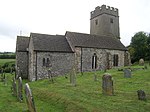Cutcombe
Civil parishes in SomersetExmoorVillages in West Somerset

Cutcombe is a village and civil parish 9 miles (14 km) south of Minehead and north of Dulverton straddling the ridge between Exmoor and the Brendon Hills in Somerset. It has a population of 361.The parish includes the hamlet of Wheddon Cross which is one of the higher hamlets within the Exmoor National Park at 980 feet (299 m) above sea level, the highest being Simonsbath.
Excerpt from the Wikipedia article Cutcombe (License: CC BY-SA 3.0, Authors, Images).Cutcombe
Higher Park Lane,
Geographical coordinates (GPS) Address Nearby Places Show on map
Geographical coordinates (GPS)
| Latitude | Longitude |
|---|---|
| N 51.1417 ° | E -3.5312 ° |
Address
Higher Park Lane
Higher Park Lane
TA24 7AN
England, United Kingdom
Open on Google Maps








